© Regents of the University of California 2003.
M. Garbelotto
Department of Environmental Science, Policy and Management, Ecosystem Science Division, 151 Hilgard Hall, University of California, Berkeley, CA 94720
J. M. Davidson
Department of Plant Pathology, One Shields Ave., University of California, Davis, CA 95616,33 Pacific Southwest Research Station, USDA Forest Service, P.O. Box 245, Berkeley, CA 94701
K. Ivors
Department of Environmental Science, Policy and Management, Ecosystem Science Division, 151 Hilgard Hall, University of California, Berkeley, CA 94720
P. E. Maloney
Department of Plant Pathology, One Shields Ave., University of California, Davis, CA 95616
D. Hüberli
Department of Environmental Science, Policy and Management, Ecosystem Science Division, 151 Hilgard Hall, University of California, Berkeley, CA 94720
S. T. Koike
University of California Cooperative Extension, 1432 Abbott Street, Salinas, CA 93901
D. M. Rizzo
Department of Plant Pathology, One Shields Ave., University of California, Davis, CA 95616
This APSnet Feature is a slightly modified version of an article first published in California Agriculture, 57:18-23. APS thanks California Agriculture for its kind permission to publish this material.

Phytophthora ramorum (Phylum Oomycota) is a recently described plant pathogen that causes a deadly canker disease of Lithocarpus densiflora, Quercus agrifolia, Q. kellogii and Q. parvula var. shrevei in California and Oregon, USA (7,12). Known as "Sudden Oak Death" in the popular press, this disease has reached epidemic proportions in oak forests along approximately 300 km of the central coast of California during the past seven years (6,12). Initial work on the disease in California concentrated on oaks and oak mortality; however, in December 2000, we learned of a possible connection with an undescribed species of Phytophthora causing a stem and leaf blight on ornamental and landscape Rhododendron and Viburnum in Germany and The Netherlands (12,15). A comparison of morphological characters and sequences of the internal transcribed spacer region of the nuclear ribosomal DNA (ITS) confirmed that the California and European pathogens were the same species of Phytophthora (12). The European Phytophthora was eventually described as P. ramorum (15) and this name was applied to the California oak pathogen (12).
The finding of P. ramorum on rhododendron in Europe led us to hypothesize that the host range of the pathogen in natural forests of California was much greater than previously suspected. Using the symptoms described for Quercus, L. densiflora, and Rhododendron as a guide, we examined and sampled leaves and stems of tree and shrub species on numerous sites with oak mortality in California. In addition to the original four host species in the Fagaceae, we have now identified an additional 13 species from 10 plant families as hosts for P. ramorum throughout its range in California forests (Table 1). Our data indicate that nearly all of the main tree species, including the coniferous timber species Sequoia sempervirens and Pseudotsuga menziesii, in mixed-evergreen and redwood-tanoak forest types may be hosts for P. ramorum. Oaks in the subgenus Quercus (i.e., the white oaks) still appear to be unaffected by P. ramorum. Understory shrubs (e.g., Arctostaphylos manzanita, Heteromeles arbutifolia, Rhamnus californica, Lonicera hispidula) are also hosts for P. ramorum.
Table 1. Known hosts, plant part infected, and original method of detection of Phytophthora ramorum in California.
| Host |
Common name |
Plant part infected |
Original
method of
detection2 |
Quercus agrifolia
(Fagaceae) |
Coast live oak |
main stem |
Culture |
Q. kellogii
(Fagaceae) |
California Black oak |
main stem |
Culture |
Q. parvula var.
shrevei (Fagaceae) |
Shreve’s oak |
main stem |
Culture |
Lithocarpus
densiflora
(Fagaceae) |
Tanoak |
main stem,
branches, leaves |
Culture |
Arbutus menziesii
(Ericaceae) |
Madrone |
branches, leaves |
PCR |
Vaccinium ovatum
(Ericaceae) |
Evergreen
huckleberry |
main stem,
branches, leaves |
Culture |
Arctostaphylos
manzanita (Ericaceae) |
Manzanita |
branches, leaves |
PCR |
Rhododendron sp.1
(Ericaceae) |
Ornamental
rhododendron |
branches, leaves |
Culture |
Rhododendron
macrophyllum
(Ericaceae) |
Rhododendron |
branches, leaves |
PCR |
Umbellularia
californica
(Lauraceae) |
Bay laurel,
Oregon myrtle |
leaves |
PCR |
Acer macrophyllum
(Aceraceae) |
Big leaf maple |
leaves |
PCR |
Heteromeles
arbutifolia
(Rosaeceae) |
Toyon |
branches, leaves |
PCR |
Aesculus californica
(Hippocastanaceae) |
California buckeye |
branches, leaves |
PCR |
Rhamnus californica
(Rhamnaceae) |
Coffeeberry |
branches, leaves |
PCR |
Lonicera hispidula
(Caprifoliaceae) |
Honeysuckle |
leaves |
PCR |
Sequoia
sempervirens
(Taxodiaceae) |
Coast redwood |
branches, leaves |
PCR |
Pseudotsuga
menziesii
(Pinaceae) |
Douglas-fir |
branches, leaves |
Culture |
1 Rhododendron cultivars from which P. ramorum has been isolated include ‘Gomer Water,’ ‘Colonel Coen,’ and ‘Cunningham’s White.’
2 Cultures of P. ramorum have been obtained from all hosts with the exception of A. manzanita.
The Discovery of New Hosts with the Aid of a DNA-based Detection Approach
Field diagnosis of P. ramorum was initially attempted via direct isolation from symptomatic plant tissue. Phytophthora species, however, are often difficult to culture from plants, which may lead to false-negative isolations and misdiagnosis of infected plants. DNA-based diagnosis consisted of a process including: (a) freeze-drying of samples, (b) grinding of infected plant tissue and DNA extraction, and (c) amplification of P. ramorum DNA using the polymerase chain reaction (PCR). Four specific PCR primers were developed based on sequences of the internal transcribed spacer (ITS) of nuclear ribosomal DNA unique to P. ramorum. The first set of primers was designed to amplify a 687 base pair (bp) fragment of the ribosomal operon including portions of the ITS1 and ITS2 and the entire 5.8S region. The second set of primers was designed to amplify a 291 bp portion of the ITS2 region, fully nested within the first amplicon. The nested PCR approach was designed to amplify P. ramorum DNA directly from plant tissue and whenever nested PCR was performed, additional controls were used including negative controls from the first run and all dilutions. In the case of new hosts or newly detected geographic areas, a full sequence of one of these two amplicons was also generated.
Cross-reactivity with other Phytophthora species was checked by amplification of pure DNA extracts from the following species: citricola, cinnamomi, cryptogea, cambivora, drechsleri, infestans, "ilicis-like," pseudotsugae, megasperma, cactorum, capsici, megasperma f. sp. glycinea, bohmeriae, parasitica, erythroseptica, nicotianae, lateralis. Cross-reactivity was only encountered when using unnatural high concentration of DNA from P. lateralis and P. cambivora. Overall, we found direct PCR amplification from symptomatic plant tissue to be more sensitive and reliable than culturing for initial detection of P. ramorum. Of the 13 non-oak host species we have identified in California, 10 were first detected using PCR amplification from infected plant material (Table 1). Although cultures of P. ramorum have been obtained from all but one host species, the time period necessary to expand the host range of this previously unknown forest pathogen was considerably shortened by the use of species-specific molecular primers.
Evaluation of P. ramorum Pathogenicity on New Hosts
Isolations of P. ramorum from symptomatic plants was the first step in determining the pathogenic role played by this microbe on new hosts. However, association between symptoms and the presence of P. ramorum does not necessarily imply a primary causal role played by this microbe, which may simply be an opportunistic colonizer of plants diseased by other agents. Pathogenicity was further tested by controlled experiments performed between May 2001 and May 2002, in which Koch’s postulate was completed for each host. All trials were duplicated.
For most experiments, three genetically different isolates of P. ramorum from three different hosts were used. Foliage inoculations were conducted by misting leaves with sterile distilled water (SDW) and then pinning inoculum plugs to the upper surface of leaves. Sterile agar plugs were used as controls. A zip-loc plastic bag was then placed over the individual leaves; prior to sealing the bag the leaves were misted again with SDW. Each trial generally consisted of 10 leaves coming from 5 different plants per host species per isolate, plus controls. In all trials, seedlings were incubated for 2 weeks in a greenhouse that was maintained at 20 to 24°C. For each trial, symptoms were recorded, lesion length and width was measured and pieces of stems or leaves were plated on PARP to verify presence or absence of P. ramorum.
Methods for stem inoculations have been previously described (12). Seedlings (stem diameter approximately 1 cm) of S. sempervirens and P. menziesii were inoculated with isolate Pr-52 in two separate trials, both trials lasted 6 weeks.
All data were analyzed by ANOVA using the software program JMP (SAS Institute Inc., Cary, NC, 1995). Where necessary, dependent variables were transformed or the ANOVA was weighted by the inverse of the variance of the residuals to control for unequal variance among treatment means. In all cases, there were no significant differences between different isolates and the different trials, so data were combined for final analysis.
Symptoms and Severity of the Disease Caused by P. ramorum on the Newly-Discovered Hosts
Symptoms of P. ramorum have only been observed on above ground plant parts such as leaves, branches, and stems, regardless of the host (Table 1, Fig. 1). In several instances, stem lesions ended at the soil line (Fig. 1). Although P. ramorum is deadly on Quercus spp. and L. densiflora, disease progression and the extent of damage on individual plants of most non-oak hosts is not well characterized at this time. On several ericaceous plant species, P. ramorum causes significant foliar blight and branch dieback (Table 1, Fig. 1). Death of Arbutus menziesii saplings in less than four months has been observed in the field (10, unpublished data) and it is suspected that the pathogen can kill mature A. menziesii trees. Death of mature Rhododendron macrophyllum has been observed in Oregon (7). On other hosts, such as Umbellularia californica, Aesculus californica and Acer macrophyllum, P. ramorum appears to be primarily a leaf pathogen with very limited stem infection. Leaf inoculations of all suspected hosts resulted in lesion formation and P. ramorum was successfully reisolated from all inoculated hosts.
| |
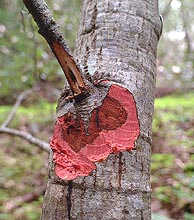
A |
|
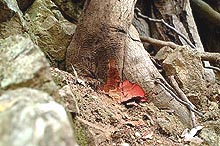
B |
|
| |
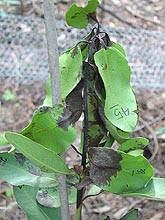
C |
|
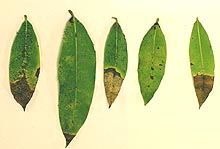
D |
|
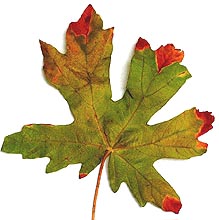
E |
|
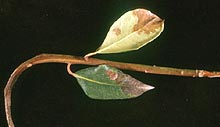
F |
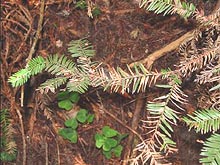
G |
|
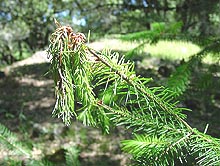
H |
Fig. 1. Symptoms of infection by Phytophthora ramorum on various hosts in California forests: (A) Lithocarpus densiflora with phloem canker on main trunk; (B) Stem canker on L. densiflora stops at the soil line; (C) Arbutus menziesii with foliar and stem lesions; (D) Umbellularia californica with leaf tip necrosis; (E) Acer macrophyllum with marginal leaf scorch; (F) Rhododendron sp. showing branch dieback and foliar lesions; (G) Sequoia sempervirens with needle necrosis on understory sapling; (H) Pseudotsuga menziesii with tip wilting due to branch cankers.
Symptoms on S. sempervirens are associated with saplings and basal sprouts on large trees. On saplings, P. ramorum causes discoloration of needles and cankers on small branches (Fig. 1), resulting in an overall decline in tree vigor. The pathogen was isolated from needles and small branches of 11 S. sempervirens saplings (2 to 15 cm diameter) at two locations (Jack London State Park, Sonoma Co. and Henry Cowell State Park, Santa Cruz Co.). Distinct purple-colored lesions have been observed on sprouts in the field and apparently lead to death of the shoots. P. ramorum was detected using the PCR diagnostic test from 12 of 90 symptomatic basal sprouts collected at 7 locations spanning the known geographic range of P. ramorum in coastal California. While it appears that P. ramorum may be relatively abundant at these sites on S. sempervirens, these results also indicate that other causes of sprout mortality may be occurring. Greenhouse inoculations of S. sempervirens stems and leaves caused similar lesions as observed in the field (Tables 2 and 3). In addition, extensive xylem discoloration was noted in sapling inoculations.
The impact of P. ramorum infection on P. menziesii is not yet clear (1). We have recovered the pathogen from infected branch tips of P. menziesii at a single location in Sonoma County. Cankers on small branches (0.5 to 1 cm diameter) resulted in wilting and dieback of branches and needles (Fig. 1). Greenhouse inoculations of individual P. menziesii leaves resulted discoloration of inoculated leaves and subsequent dieback of adjacent leaves and twigs. Inoculations of stems resulted in resinosis from the bark, cambial necrosis, and dieback and discoloration of foliage. Symptoms on P. menziesii do not appear to be common in the field at this time and have not been observed on overstory trees.
Epidemiology of P. ramorum in California
Across the range of known hosts, we can distinguish two different types of diseases: non-lethal foliar and twig infections, and lethal branch or stem infections. Foliar infections play a key role in the epidemiology of P. ramorum by serving as a source of inoculum which is then spread aerially through rainsplash (1). The most likely dispersal propagules of P. ramorum, sporangia and chlamydospores, are readily produced on foliage (particularly of U. californica and Rhododendron spp.), but we have yet to find them on infected oak bark. Therefore, P. ramorum epidemics in California oak forests may be driven by the presence and susceptibility of associated plant hosts, not the oaks themselves. Two recent studies have reported a significant association between the presence of U. californica trees and P. ramorum infection on Quercus spp. (8,14) and our preliminary studies indicate that foliar host infection may precede infection of Quercus spp. and L. densiflora on a site. We hypothesize that P. ramorum may need to produce inoculum on the leaves of these associated hosts to serve as a springboard to oak species. Hosts with relatively small lesions may be especially important in the transmission biology of P. ramorum because such lesions do not kill leaves but can support abundant sporulation for extended periods of time.
The hypothesis that P. ramorum may need multiple plant hosts to cause epidemics is also supported by the results of molecular genetic analyses of P. ramorum populations. Genetic fingerprinting on a number of California, Oregon, and European isolates is under way using a technique called amplified fragment length polymorphisms (AFLPs) (14). Recent studies (6, unpublished data) reveal that a single individual of P. ramorum has been clonally reproducing and is responsible for over 80% of all infections in California and Oregon. The genetic analysis thus confirms that the same individual is capable of infecting all hosts. This result is significant because identically-looking pathogens isolated from different hosts may represent undistinguishable but genetically different microorganisms. In addition to the results stemming from the genetic analyses, inoculation of all hosts with cultures isolated from oaks and rhododendron always resulted in typical disease symptoms. Such data strongly suggest that the pathogen moves from one host to another with no evidence of host specificity of different isolates.
Establishment and spread of P. ramorum may thus be mediated by foliar infections on a variety of hosts. Furthermore, both reproductive (e.g., sporangia) and resting (e.g., chlamydospores) structures have been found to accumulate in soil and water (2). Preliminary results indicate that plant material can become infected if placed in contact with infested soil or water. Infested soil and water are likely to play an important role both in the natural and artificial transmission of this pathogen.
The presence of the pathogen has been confirmed in 12 California counties. From north to south, they are: Humboldt, Mendocino, Sonoma, Napa, Solano, Marin, Contra Costa, Alameda, San Mateo, Santa Clara, Santa Cruz, and Monterey. Levels of infestation vary significantly among counties. While large areas within Marin, Santa Cruz, Sonoma, and Monterey counties are severely affected, the disease is still sporadically present in all other counties. It has been hypothesized that P. ramorum may be a pathogen thriving in cool and moist environments; if so, extent and severity of the diseases caused by this pathogen may be correlated to temperature and moisture conditions.
P. ramorum growth is optimal at temperatures between 18 and 22°C (15). Laboratory trials have recently shown that bay leaves infection rate may average 92% at 18°C, but may only average 50% and 37%, at the less favorable temperatures of 12 and 30°C, respectively (unpublished data). Besides cool temperatures, the presence of free water on plant surfaces is needed for efficient infection by the pathogen. P. ramorum produces infectious propagules, called zoospores, that need to swim in a liquid environment in order to reach a susceptible host. Preliminary studies have indicated that a minimum of 6 to 12 hours of free-standing water was required for infection of bay leaves. Rain, fog or dew accumulation may result in the formation of a persistent film of water on plant surfaces.
Studies based on isolations of P. ramorum from infested soil (J. Davidson and P. Maloney, unpublished data) indicate pathogen activity starts after repeated precipitation events and peaks during spring months. Dry and warm summer and fall weather result in a sharp decrease, and eventually in a complete arrest, of P. ramorum activity in soil. Activity of the pathogen on living plants can be inferred by isolation success of P. ramorum from symptomatic plants in the field. Results from two years of collections, indicated that isolation success from living plants decreases sharply in the summer and fall months.
Conclusions
A broad host range and a predominant clonal reproductive strategy are not unprecedented in the genus Phytophthora (3). Phytophthora cinnamomi is known to be mostly clonally reproducing and to attack over 2000 plant species with significant ecological damage to forest ecosystems in Australia, Europe, and North America. The broad host range of P. ramorum, the variability of symptoms among different hosts, and the ability of the pathogen to be aerially dispersed suggests that this pathogen may also have the potential to cause similar, long-term landscape level changes in California forests. Hosts for P. ramorum include canopy trees and understory shrubs. The long term consequences regarding mortality for non-oak hosts are unknown at this time. However, branch dieback on these non-oak hosts may affect leaf and seed production, negatively impact growth and regeneration, and lead to predisposition to attacks by other pathogens and insects. Sub-lethal infections of non-oak hosts may also allow P. ramorum to persist indefinitely in infested forests and affect the success of future regeneration and restoration efforts. It is unclear at this time what the long-term consequences will be for harvesting and regeneration of S. sempervirens and P. menziesii. However, the observation of P. ramorum in the xylem of a large S. sempervirens, the results of the inoculation studies for both conifers, and the detection of P. ramorum in dying sprouts and branches suggests that the situation requires more extensive research.
The apparent limited gene pool of P. ramorum in North America, combined with the extreme susceptibility of some hosts, and the limited known area of distribution of the pathogen are suggestive of an introduced organism, but the actual origin and global genetic structure of the pathogen remains unknown. Because of uncertainty about the origin, distribution and host range of P. ramorum, and because many of the known hosts have a range well beyond California, the United States (APHIS), Canada, United Kingdom, and South Korea have implemented quarantines against movement of plant material and/or soil from California and Oregon. The United States has implemented similar restrictions on movement of plant material from Europe. The discovery that even small foliar lesions may potentially be epidemiologically important, combined with the difficulties encountered in culturing the pathogen, is proving to be challenging from a regulatory and monitoring perspective. The use of DNA-based diagnostic test outlined here offers a reliable approach to detect P. ramorum, follow its movement, and ultimately understand its biology.
While regulatory actions may be able to prevent the spread of this pathogen to new areas, California coastal forest ecosystems are currently witnessing an expansion of the infestation caused by P. ramorum. Natural spread of the disease in California will be affected by weather patterns and by the presence of genetic resistance in the susceptible hosts. Preliminary studies (Dodd and Garbelotto, unpublished) indicate that individuals of both bay laurel and coast live oak display differential levels of resistance to the disease.
In order to assist the natural recovery of the ecosystem, it is essential to fully understand the biology of the pathogen and to identify forest management approaches that may be detrimental to the spread of the pathogen. In Western Australia (8), targeted chemical treatments may also significantly slow down the spread of the disease. Results from a series of ongoing studies (5) have indicated that it may be possible to employ chemical treatments to prevent infection by P. ramorum on individual trees. The availability of such treatments, and their careful application, may add a useful tool to an integrated control approach for this ecosystem-level disease.
Acknowledgements
This research has been supported by grants from the USDA Forest Service and the Gordon and Betty Moore Foundation. The technical assistance of A. Wickland, S. Murphy, S. Kane, C. Jensen, G. Slaughter, D. Schmidt, J. Tse, T. Harnik, K. Hayden, A. Smith, Will Van Sant, and D. Henderson is greatly appreciated. The European isolates were provided by S. Werres . Additional samples provided by E. Hansen, K. Bovero, R. Gross, S. Tjosvold, and P. Mordike. Comments on the manuscript by T. Bruns and E. Hansen are greatly appreciated.
Additional Resources
California Agriculture
Forest Pathology and Mycology Laboratory
University of California Cooperative Extension
California Oak Mortality Task Force (COMTF)
PDF of the original California Agriculture article:
"Non-oak native plants are main hosts for
sudden oak death pathogen in California"
Sudden Oak Death: How Concerned Should You Be?
(An International Symposium · April 21 - May 4, 2003)
Literature Cited
1. Davidson, J. M., Garbelotto, M., Koike, S. T., and Rizzo, D. M. 2002. First report of Phytophthora ramorum on Douglas-fir in California.. Plant Dis. 86:1274
2. Davidson, J. M., Rizzo, D. M., and Garbelotto, M. 2002. Phytophthora ramorum and Sudden Oak Death in California: II. Pathogen transmission and survival. Pages 741-749 in: 5th Symposium on California Oak Woodlands, R. Standiford and D. McCreary, eds., USDA Forest Service, Gen. Tech. PSW-GTR-184.
3. Erwin, D. C., and Ribeiro, O. K. 1996. Phytophthora Diseases Worldwide. American Phytopathological Society, St. Paul, MN.
4. Garbelotto, M., Rizzo, D. M., Hayden, K., Davidson, J. M., and Tjosvold, S. 2002. Phytophthora ramorum and Sudden Oak Death in California: III. Pathogen genetics. Pages 765-774 in: 5th Symposium on California Oak Woodlands. R. Standiford and D. McCreary, eds. USDA Forest Service, Gen. Tech. PSW-GTR-184.
5. Garbelotto, M., Rizzo, D. M., and Marais, L. 2002. Phytophthora ramorum and Sudden Oak Death in California: IV. chemical control. Pages 811-818 in: 5th Symposium on California Oak Woodlands. R. Standiford and D. McCreary, eds. USDA Forest Service, Gen. Tech. PSW-GTR-184.
6. Garbelotto, M., Svihra, P., and Rizzo, D. M. 2001. Sudden oak death syndrome fells three oak species. Calif. Agric. 55:9-19.
7. Goheen, E. M., Hansen, E. M., Kanaskie, A., McWilliams, M. G., Osterbauer, N. and Sutton, W. 2002. Sudden oak death caused by Phytophthora ramorum in Oregon. Plant Dis. 86:441.
8. Hardy, G. E. St. J., Barrett, S., Shearer, B. L. 2001. The future of phosphite as a fungicide to control the soilborne plant pathogen Phytophthora cinnamomi In natural ecosystems. Australasian Plant Path. 30:133-139.
9. Kelly, N. M., and Meentemeyer, R. 2002. Landscape dynamics of the spread of Sudden Oak Death. Photo. Eng. Rem. Sens. 68:1001-1009.
10. Maloney, P. E., Rizzo, D. M., Koike, S. T., Harnik, T. Y., and Garbelotto, M. 2002. First report of Phytophthora ramorum on coast redwood in California. Plant Dis. 86:1274.
11. Rizzo, D. M., Garbelotto, M., Davidson, J. M., Slaughter, G. W., and Koike, S. 2002. Phytophthora ramorum as the cause of extensive mortality of Quercus spp. and Lithocarpus densiflorus in California. Plant Dis. 86:205-214.
12. Rizzo, D. M., Garbelotto, M., Davidson, J. M., Slaughter, G. W., and Koike, S. T. 2002. Phytophthora ramorum and Sudden Oak Death in California: I. Host Relationships. Page 733-740 in: 5th Symposium on California Oak Woodlands. R. Standiford and D. McCreary, eds. USDA Forest Service, Gen. Tech. PSW-GTR-184.
13. Swiecki, T. J., and Bernhardt, E. 2002. Evaluation of stem water potential and other tree and stand variables as risk factors for Phytophthroa ramorum canker development in coast live oak. Pages 787-798 in: 5th Symposium on California Oak Woodlands. R. Standiford and D. McCreary, eds. USDA Forest Service, Gen. Tech. PSW-GTR-184.
14. Vos, P., Hogers, R., Bleeker, M., Reijans, M., Van De Lee, T., Hornes, M., Frijters, A., Pot, J., Peleman, J., Kuiper, M., Zabeau, M. 1995. AFLP: A new technique for DNA fingerprinting. Nucleic Acids Research 1995. 23:4407-4414.
15. Werres, S., Marwitz, R., Man In’T Veld, W. A., De Cock, A. W. A. M., Bonants, P. J. M., De Weerdt, M., Themann, K., Ilieva, E., and Baayen, R. P. 2001. Phytophthora ramorum sp. nov., a new pathogen on Rhododendron and Viburnum. Mycol. Res. 105:1155.
